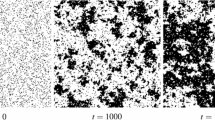Abstract
This is the first part of a series devoted to the study of thermodynamic behavior of large dynamical systems with the use of a family of fully-discrete and conservative models named elementary reversible cellular automata (ERCAs). In this paper, basic properties such as conservation laws and phase space structure are investigated in preparation for the later studies. ERCAs are a family of one-dimensional reversible cellular automata having two Boolean variables on each site. Reflection and Boolean conjugation symmetries divide them into 88 equivalence classes. For each rule, additive conserved quantities written in a certain form are regarded as a kind of energy, if they exist. By the aid of the discreteness of the variables, every ERCA satisfies the Liouville theorem or the preservation of phase space volume. Thus, if an energy exists in the above sense, statistical mechanics of the model can formally be constructed. If a locally defined quantity is conserved, however, it prevents the realization of statistical mechanics. The existence of such a quantity is examined for each class and a number of rules which have at least one energy but no local conservation laws are selected as hopeful candidates for the realization of thermodynamic behavior. In addition, the phase space structure of ERCAs is analyzed by enumerating cycles exactly in the phase space for systems of comparatively small sizes. As a result, it is revealed that a finite ERCA is not ergodic, that is, a large number of orbits coexist on an energy surface. It is argued that this fact does not necessarily mean the failure of thermodynamic behavior on the basis of an analogy with the ergodic nature of infinite systems.
Similar content being viewed by others
References
J. L. Lebowitz, inTransport Phenomena, G. Kirczenow and J. Marro, eds. (Springer-Verlag, Berlin, 1973).
V. I. Arnol'd,Russ. Math. Surv. 18:9, 85 (1963).
S. Goldstein, J. L. Lebowitz, and M. Aizenman, inDynamical Systems, Theory and Applications, J. Moser, ed. (Springer-Verlag, Berlin, 1975).
I. P. Cornfeld, S. V. Fomin, and Ya. G. Sinai,Ergodic Theory (Springer-Verlag, New York, 1982).
O. E. Lanford, III, and J. L. Lebowitz, inDynamical Systems, Theory and Applications, J. Moser, ed. (Springer-Verlag, Berlin, 1975).
S. Takesue,Phys. Rev. Lett. 59:2499 (1987).
S. Wolfram, ed.,Theory and Application of Cellular Automata (World Scientific, Singapore, 1986).
Y. Pomeau,J. Phys. A 17:L415 (1984).
R. S. MacKay and J. D. Meiss, eds.,Hamiltonian Dynamical Systems (Adam Hilger, Bristol, 1987).
M. Creutz,Ann. Phys. 167:62 (1986).
G. Vichniac,Physica 10D:117 (1984).
G. Vichniac, inDisordered Systems and Biological Organization, B. Bienenstock, F. Fogelman Soulie, and G. Weissbuch, eds. (Springer-Verlag, Berlin, 1986).
H. J. Herrmann,J. Stat. Phys. 45:145 (1986); U. M. S. Costa and H. J. Herrmann,J. Stat. Phys. 47:597 (1987); H. J. Herrmann, H. O. Carmesin, and D. Stauffer,J. Phys. A 20:4939 (1987); M. Schulte, W. Stiefelhagen, and E. S. Demme,J. Phys. A 20:L1023 (1987); W. M. Lang and D. Stauffer,J. Phys. A 20:5413 (1987); H. E. Stanley, D. Stauffer, J. Kertész, and H. J. Herrmann,Phys. Rev. Lett. 59:2326 (1987); R. Toral,J. Phys. A 21:L315 (1988); R. C. Desai and D. Stauffer,J. Phys. A 21:L59 (1988).
N. Sourlas,Europhys. Lett. 6:561 (1988).
Y. Pomeau and G. Y. Vichniac,J. Phys. A 21:3297 (1988).
J. Hardy and Y. Pomeau,J. Math. Phys. 13:1042 (1972); J. Hardy, Y. Pomeau, and O. de Pazzis,J. Math. Phys. 14:1746 (1973); J. Hardy, O. de Pazzis, and Y. Pomeau,Phys. Rev. A 13:1949 (1976); U. Frisch, B. Hasslacher, and Y. Pomeau,Phys. Rev. Lett. 56:1505 (1986); D. d'Humières, P. Lallemand, and U. Frisch,Europhys. Lett. 2:291 (1986); S. Wolfram,J. Stat. Phys. 45:471 (1986); L. P. Kadanoff, G. R. McNamara, and G. Zanetti,Complex Systems 1:791 (1987); B. Chopard and M. Droz,Phys. Lett. A 126:476 (1988); A. J. C. Ladd, M. E. Colvin, and D. Frenkel,Phys. Rev. Lett. 60:975 (1988); S. Succi, P. Santangelo, and R. Benzi,Phys. Rev. Lett. 60:2738 (1988).
O. E. Lanford, III, inDynamical Systems, Theory and Applications, J. Moser, ed. (Springer-Verlag, Berlin, 1975).
S. Wolfram,Rev. Mod. Phys. 55:601 (1983).
G. Cosenza and F. Neri,Physica 27D:357 (1987).
E. Goles and G. Y. Vichniac,J. Phys. A 19:L961 (1986).
N. Margolus,Physica 10D:81 (1984).
S. Wolfram,Physica 10D:1 (1984).
O. Martin, A. M. Odlyzko, and S. Wolfram,Commun. Math. Phys. 93:219 (1984).
M. Henon, inChaotic Behavior of Deterministic Systems (North-Holland, Amsterdam, 1983).
Author information
Authors and Affiliations
Rights and permissions
About this article
Cite this article
Takesue, S. Ergodic properties and thermodynamic behavior of elementary reversible cellular automata. I. Basic properties. J Stat Phys 56, 371–402 (1989). https://doi.org/10.1007/BF01044442
Received:
Revised:
Issue Date:
DOI: https://doi.org/10.1007/BF01044442




